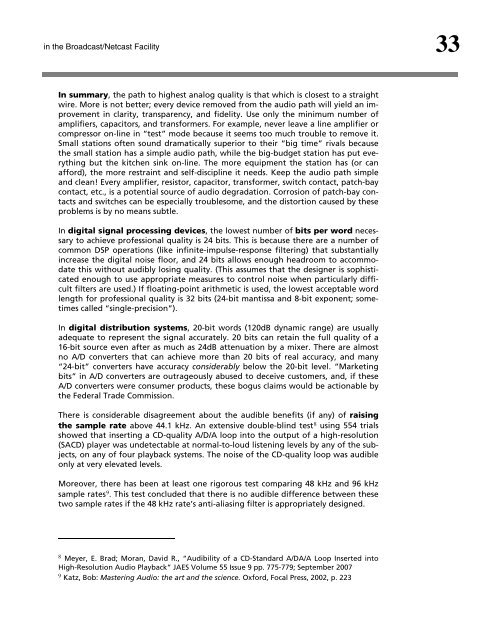Maintaining Audio Quality in the Broadcast Facility 2011 - Orban
Maintaining Audio Quality in the Broadcast Facility 2011 - Orban
Maintaining Audio Quality in the Broadcast Facility 2011 - Orban
Create successful ePaper yourself
Turn your PDF publications into a flip-book with our unique Google optimized e-Paper software.
<strong>in</strong> <strong>the</strong> <strong>Broadcast</strong>/Netcast <strong>Facility</strong> 33<br />
In summary, <strong>the</strong> path to highest analog quality is that which is closest to a straight<br />
wire. More is not better; every device removed from <strong>the</strong> audio path will yield an improvement<br />
<strong>in</strong> clarity, transparency, and fidelity. Use only <strong>the</strong> m<strong>in</strong>imum number of<br />
amplifiers, capacitors, and transformers. For example, never leave a l<strong>in</strong>e amplifier or<br />
compressor on-l<strong>in</strong>e <strong>in</strong> “test” mode because it seems too much trouble to remove it.<br />
Small stations often sound dramatically superior to <strong>the</strong>ir “big time” rivals because<br />
<strong>the</strong> small station has a simple audio path, while <strong>the</strong> big-budget station has put everyth<strong>in</strong>g<br />
but <strong>the</strong> kitchen s<strong>in</strong>k on-l<strong>in</strong>e. The more equipment <strong>the</strong> station has (or can<br />
afford), <strong>the</strong> more restra<strong>in</strong>t and self-discipl<strong>in</strong>e it needs. Keep <strong>the</strong> audio path simple<br />
and clean! Every amplifier, resistor, capacitor, transformer, switch contact, patch-bay<br />
contact, etc., is a potential source of audio degradation. Corrosion of patch-bay contacts<br />
and switches can be especially troublesome, and <strong>the</strong> distortion caused by <strong>the</strong>se<br />
problems is by no means subtle.<br />
In digital signal process<strong>in</strong>g devices, <strong>the</strong> lowest number of bits per word necessary<br />
to achieve professional quality is 24 bits. This is because <strong>the</strong>re are a number of<br />
common DSP operations (like <strong>in</strong>f<strong>in</strong>ite-impulse-response filter<strong>in</strong>g) that substantially<br />
<strong>in</strong>crease <strong>the</strong> digital noise floor, and 24 bits allows enough headroom to accommodate<br />
this without audibly los<strong>in</strong>g quality. (This assumes that <strong>the</strong> designer is sophisticated<br />
enough to use appropriate measures to control noise when particularly difficult<br />
filters are used.) If float<strong>in</strong>g-po<strong>in</strong>t arithmetic is used, <strong>the</strong> lowest acceptable word<br />
length for professional quality is 32 bits (24-bit mantissa and 8-bit exponent; sometimes<br />
called “s<strong>in</strong>gle-precision”).<br />
In digital distribution systems, 20-bit words (120dB dynamic range) are usually<br />
adequate to represent <strong>the</strong> signal accurately. 20 bits can reta<strong>in</strong> <strong>the</strong> full quality of a<br />
16-bit source even after as much as 24dB attenuation by a mixer. There are almost<br />
no A/D converters that can achieve more than 20 bits of real accuracy, and many<br />
“24-bit” converters have accuracy considerably below <strong>the</strong> 20-bit level. “Market<strong>in</strong>g<br />
bits” <strong>in</strong> A/D converters are outrageously abused to deceive customers, and, if <strong>the</strong>se<br />
A/D converters were consumer products, <strong>the</strong>se bogus claims would be actionable by<br />
<strong>the</strong> Federal Trade Commission.<br />
There is considerable disagreement about <strong>the</strong> audible benefits (if any) of rais<strong>in</strong>g<br />
<strong>the</strong> sample rate above 44.1 kHz. An extensive double-bl<strong>in</strong>d test 8 us<strong>in</strong>g 554 trials<br />
showed that <strong>in</strong>sert<strong>in</strong>g a CD-quality A/D/A loop <strong>in</strong>to <strong>the</strong> output of a high-resolution<br />
(SACD) player was undetectable at normal-to-loud listen<strong>in</strong>g levels by any of <strong>the</strong> subjects,<br />
on any of four playback systems. The noise of <strong>the</strong> CD-quality loop was audible<br />
only at very elevated levels.<br />
Moreover, <strong>the</strong>re has been at least one rigorous test compar<strong>in</strong>g 48 kHz and 96 kHz<br />
sample rates 9 . This test concluded that <strong>the</strong>re is no audible difference between <strong>the</strong>se<br />
two sample rates if <strong>the</strong> 48 kHz rate’s anti-alias<strong>in</strong>g filter is appropriately designed.<br />
8 Meyer, E. Brad; Moran, David R., “Audibility of a CD-Standard A/DA/A Loop Inserted <strong>in</strong>to<br />
High-Resolution <strong>Audio</strong> Playback” JAES Volume 55 Issue 9 pp. 775-779; September 2007<br />
9 Katz, Bob: Master<strong>in</strong>g <strong>Audio</strong>: <strong>the</strong> art and <strong>the</strong> science. Oxford, Focal Press, 2002, p. 223



![[PDF] Using the ITU BS.1770-2 and CBS Loudness Meters ... - Orban](https://img.yumpu.com/50629372/1/190x245/pdf-using-the-itu-bs1770-2-and-cbs-loudness-meters-orban.jpg?quality=85)






![[PDF] Optimod-FM Feature Comparison - Orban](https://img.yumpu.com/41741615/1/190x245/pdf-optimod-fm-feature-comparison-orban.jpg?quality=85)






